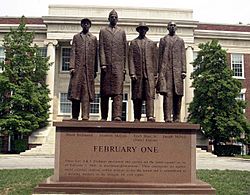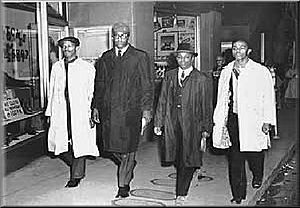February One facts for kids
| A&T Four Monument | |

The February One Monument on the Campus of North Carolina A&T State University
|
|
| Coordinates | 36°4′29.14″N 79°46′38.27″W / 36.0747611°N 79.7772972°W |
|---|---|
| Location | Greensboro, North Carolina United States |
| Designer | James Barnhill (artist) |
| Material | Bronze, Marble |
| Length | 3 feet |
| Width | 10 feet |
| Height | 15 feet |
| Beginning date | 2001 |
| Completion date | 2002 |
| Opening date | February 1, 2002 |
| Dedicated to | Ezell Blair Jr. Franklin McCain Joseph McNeil David Richmond |
The February One monument, also called the A&T Four Monument, was built in 2002. It honors four brave young men: Ezell Blair Jr., Franklin McCain, Joseph McNeil, and David Richmond. They are known together as the Greensboro Four.
This monument is 15 feet tall and made of bronze and marble. You can find it on the campus of North Carolina Agricultural and Technical State University in Greensboro, North Carolina. The artist, James Barnhill, was inspired by a famous photo from 1960. This photo showed the four college students leaving a Woolworth store. They had just held a sit-in protest because the store had separate lunch counters for different races. These sit-ins were a very important part of the Civil Rights Movement in American history. They helped bring more attention to the fight for equal rights for African Americans.
Contents
About the Artist: James Barnhill
James Barnhill, born in 1955, is the talented artist who created the February One monument. He grew up in Asheville, North Carolina. He studied art at the University of North Carolina at Chapel Hill and later earned a special degree in sculpture from the University of North Carolina at Greensboro.
Barnhill has created many other impressive sculptures. For example, he made Minerva for the UNC Greensboro campus. He also sculpted a bronze statue of Booker T. Washington for the Booker T. Washington National Monument. Another of his works is General Greene, a statue of the Revolutionary War General Nathanael Greene. The city of Greensboro asked him to create this for its 200th birthday celebration. Today, James Barnhill teaches art at North Carolina A&T State University.
The February One Sculpture

The February One monument was commissioned in 2001. This means the university asked James Barnhill to create it. It took him a whole year to finish the statue. The monument stands 15 feet (4.6 m) tall.
The four figures on the statue are larger than life, each about 10 feet (3.0 m) tall. They look like David Richmond, Franklin McCain, Jibreel Khazan (who was known as Ezell Blair Jr. then), and Joseph McNeil. These are the four A&T students who became famous as the "Greensboro Four". Their sit-in at Woolworth's department store in 1960 was a major event.
The figures show the group walking out of Woolworth's after their protest. Barnhill said he wanted to show them marching. He felt this would better capture their spirit and make a stronger visual impact than showing them sitting.
The base of the statue is 5 feet (1.5 m) tall. It has the names of the four men carved into it. It also has an important message: "These four A&T Freshmen envisioned and carried out the lunch counter sit-in of February 1, 1960 in downtown Greensboro. Their courageous act against social injustice inspired similar progress across the nation and is remembered as a defining moment in the struggle for civil rights."
To build the statue, Barnhill first made metal frames for each person. He then covered these frames with over 6,000 pounds of clay. After that, molds were made. These molds were sent to a special place called a foundry. There, the bronze figures were created.
Monument Dedication Ceremony
On February 1, 2002, the February One statue was officially revealed. This happened at a special ceremony on the North Carolina A&T campus. The event was part of a day-long celebration. It marked the 42nd anniversary of the famous Greensboro Sit-Ins.
Many people spoke at the ceremony. These included the university's leader, James C. Renick, and the artist, James Barnhill. Franklin McCain, one of the Greensboro Four, also spoke. All three living members of the Greensboro Four attended the dedication. David Richmond, who had passed away in 1990, was represented by his son, David "Chip" Richmond Jr.
Why the Sit-Ins Were Important
"It's a monument of four guys, not military members or presidents, These were just people...who became heroes."
(on the inspiration and symbolism behind the sculpture)
The actions of the Greensboro Four were very important. They helped to increase support across the country for the Civil Rights Movement. As news of their protests spread, similar demonstrations began all over the Southern United States.
People in other southern cities started protesting. They wanted not only lunch counters to be desegregated, but also other public places. This included places like bus stations, art galleries, beaches, parks, swimming pools, libraries, and even museums.
Overall, the sit-ins were very successful. They led to the desegregation of lunch counters and many other public places throughout the South. For example, in Nashville, Tennessee, the sit-ins by the Nashville Student Movement had such a big impact that public places became desegregated by May 1960.

